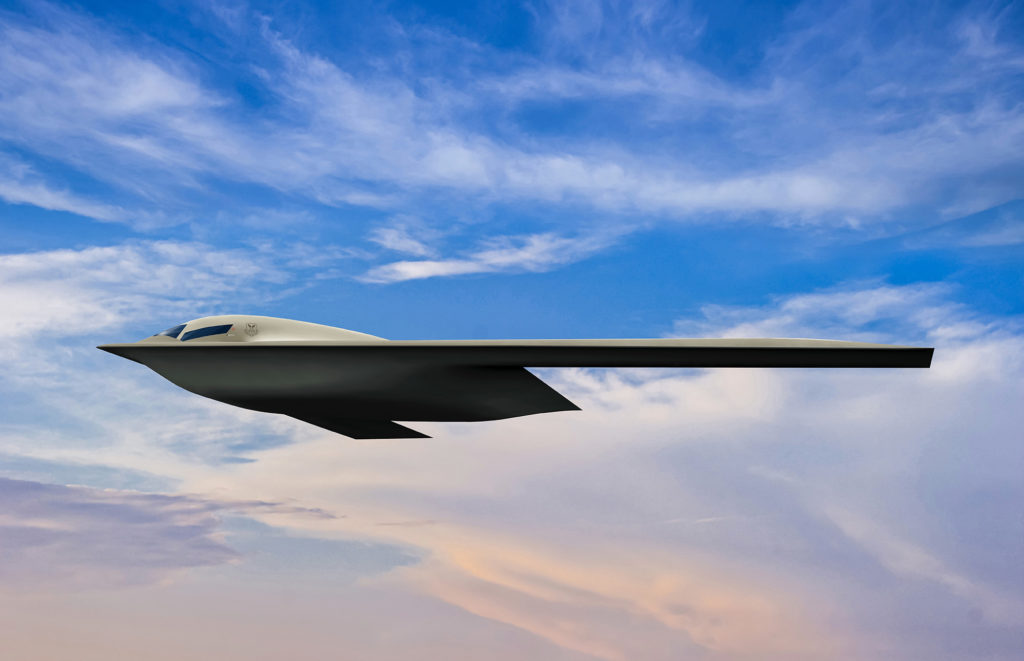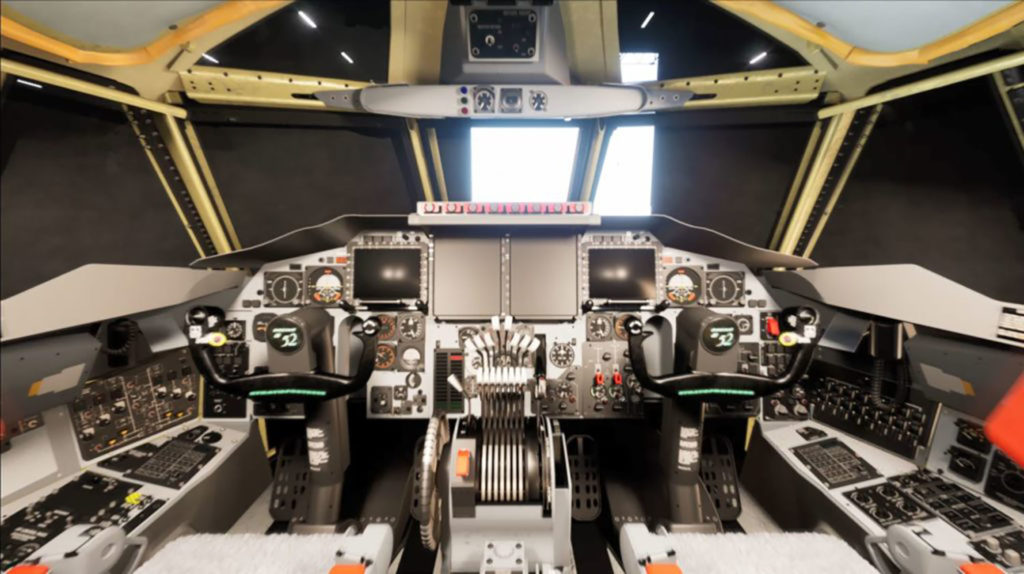What the B-52 Will Look Like After Engine, Radar Upgrades
By John A. Tirpak
The first images of the updated B-52 Stratofortress, featuring new Rolls-Royce engines, new radar, and a new, streamlined cockpit emerged in October, changes that are significant enough to warrant re-designating the B-52H configurations as the B-52J or K.
Exterior images were rendered from a digital prototyping model, but should closely resemble the final version. The larger-diameter fans in the new Rolls-Royce North America F130 engines are prominent, set higher and farther forward in their nacelles than are the legacy Pratt & Whitney TF-33s that have powered B-52s since 1962. The new engines are set higher to provide more ground clearance. Flight-testing will seek to determine precisely how the new engines and their positioning will change the way the wing and flap system performs.
The aircraft’s nose will also be streamlined, losing the blisters that house its forward-looking infrared/electro-optical viewing system. The new radar is a variant of the AN/APG-79 in the Navy’s F/A-18E/F SuperHornet. The radar will assume some of the functions formerly provided by the FLIR/EO system, while others will be supported by either a Litening or Sniper targeting pod, which the B-52 can carry on a wing pylon.
Inside, the B-52 is getting an updated cockpit, a “hybrid” analog-digital engine control system, communications and navigation enhancements, and the deletion of one crew member station. A digital image of the planned cockpit shows a streamlined appearance with four 8-by-10-inch mulit-function color displays and a range of conventional analog gauges.
At least some of the B-52 fleet will be operational with both new radars and new engines by the end of the decade.
The center console will feature an updated throttle station to control the new engines, which will be digitally managed.
Boeing described the new throttle system as “hybrid mechanical-to-digital,” and listed components including “new data concentrators units (2x), a new engine fault maintenance recorder, new engine air data system [and] modified system panels, as well as structural, electrical, pneumatic and hydraulic updates associated with this modernization effort.”
On the exterior, two large humps on top of the fuselage, near the wing roots seem larger than any fairings or blisters now in that area, which house GPS and other comm/nav equipment. A Boeing spokesperson declined to comment on the apparent change, but the location and size suggest the potential for a larger, anti-jam GPS antenna.
Given the combined engine/radar upgrades, the changes represent “the largest modification in the history” of the B-52, noted Air Force Col. Louise Ruscetta, senior materiel leader for the B-52, in August. There may be an interim designation because the radar will be installed before the engines and will drive a change in operating and maintenance manuals and documentation. Manuals would change again once the engines are replaced.
The Air Force and Air Force Global Strike Command are still deciding how to define those distinctions, Ruscetta said.
The new radar is an active electronically scanned array type as used by fighters. It will take up far less room than the old mechanically scanned system, so the change will create growth space for electronic warfare functions, Ruscetta noted. At least some of the B-52 fleet will be operational with both new radars and new engines by the end of the decade.
B-21 Bomber Roll Out Set for Dec. 2
Success will determine how soon B-1s, B-2s are retired.

By John A. Tirpak
The Air Force and Northrop Grumman will roll out the B-21 Raider, the Air Force’s first new bomber since the B-2 Spirit emerged from the same facility in 1988, in December.
The invitation-only event will include Air Force and political dignitaries and a limited number of media. Photography will be permitted, but restricted; both the size of lenses and viewing angles will be limited.
The B-21 must come out of its high-security production facility to begin outside engine runs and taxi tests in preparation for its first flight, meaning aircraft will be visible from outside the plant in the coming months. First flight is anticipated in mid-2023. The Air Force has previously said six B-21s are in various stages of construction.
When the Air Force awarded the contract for the program—then known as the Long-Range Bomber—in 2015, the service said it would have at least one article ready for operational use in “the mid-2020s.” It has not wavered from that prediction. Air Force Global Strike Command has voiced a requirement for as many as 150 B-21s, but officially, the Air Force’s requirement is for “at least 100” of the aircraft.
Meanwhile, plans to retire the B-1 and B-2 bombers hinge largely on how fast the B-21 can be fielded.
“The approach we’re taking,” said Brig. Gen. (select) William S. Rogers in a recent interview, is to maintain “our current capability and readiness in terms of our near-peer adversary.”
Air Force Global Strike Command is “really focused on maintaining that readiness, availability, survivability, and operational capability” of its B-1s and B-2s, he said, “while we get ready for the B-21 fielding.”
The Air Force disclosed plans to retire the B-1 and B-2 in its 2018 Bomber Roadmap, targeting the 2031-2032 time frame. USAF has not publicly updated those plans since. At the time, the Air Force acknowledged a short-term capacity gap; changing security circumstances could easily alter those plans.
The Rapid Capabilities Office, which manages development of the B-21, is taking an “events-based approach” to fielding the new aircraft, Rogers said. “Divestiture planning” must consider “unplanned delays on the B-21 or if things just change.”
He noted that “Congress gets a say in our divestiture plans, but at this point, we’re looking at multiple … avenues, to make sure the Air Force has the flexibility needed” and to provide as many options as possible for the Secretary of Defense and the President.
Both the B-1 and B-2 suffer from supply chain challenges, and the Air Force Life Cycle Management Center is “working with the primes on parts obsolescence,” Rogers said. In some cases, subcontractors “went out of business.” When that happens, the Air Force must seek form, fit, and function replacements “that may be out there” in the marketplace or new sources if parts must be custom-ordered.
The B-1 and B-2 are doing well in terms of aircraft availability rates—the preferred metric over mission capability rates—and are hitting their goals, Rogers said. B-1 aircraft availability is 42 percent and B-2 availability is 55 percent, he said.
When the Air Force retired 17 B-1s last year, availability surged because incapable aircraft were no longer in the count and more maintainers and parts were available for each remaining airplane.
Results of a B-1B carcass physical teardown as well as a fatigue test on another carcass and the creation of a “digital twin” of the airplane are expected to yield benefits in availability over the long term, as the Air Force moves toward a predictive maintenance model.
Early discussions have taken place about what to do with the B-2 after it’s retired. Due to its sensitive and secret materials, if the aircraft are to be stored, they will need a special climate-controlled and secure facility for that purpose. The bomber PEO shop is watching to see what the Air Force decides to do with the 33 F-22s it is trying to retire, pending congressional approval. Whatever approach is taken will likely set the stage for B-2 storage, Rogers said.
The B-1 and B-2 have largely completed their modernization programs, but Rogers said the term “modernization through sustainment” summarizes the approach to be taken, which means software updates will take an open approach to make improvements easy to add. AFGSC may yet need improved communications in “a highly contested environment” or advanced weapons.
“Any upgrades [or] mods are really focused on keeping it viable and operationally relevant as needed, until the Air Force makes final decisions on divestiture,” Rogers noted. Major upgrades of aircraft destined for mid-term retirement aren’t affordable right now, so the goal is to only make “wise choices” for inexpensive improvements that can add significant capability “without a lot of development.”
For the B-2, the only new weapon in process is the B61-12 nuclear bomb. There is “not currently a requirement” to outfit the B-2 with capabilities to direct numbers of collaborative combat aircraft—uncrewed, re-usable, or “attritable” air vehicles likely to make up a big part of the 2030s USAF force structure.
For the B-1, however, new weapons are likely, but Rogers couldn’t give details due to classification.
“Anything additional at this time is classified and early in planning. … At this point, I can’t discuss it,” he said. However, AGFSC has said it plans to fit the B-1 and B-52 with hypersonic weapons. Both aircraft will carry the weapons externally, and the B-1 will carry the AGM-183 Air-launched Rapid Response Weapon (ARRW) on external hardpoints once used for nuclear cruise missiles, when that aircraft had a nuclear mission.



